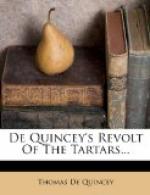15 10. Paladins. A term used especially to designate the famous knightly champions who served the Frankish Charlemagne. Look up the etymology of the word and trace its present meaning.
15 24. ukase. “An edict or order, legislative or administrative, emanating from the Russian government.”—Century Dictionary.
16 9. mummeries. Find the original meaning of this word.
16 22. Catharine II. “Elizabeth had been succeeded in 1762 by her nephew Peter III., who had reigned but a few months when he was dethroned by a conspiracy of Russian nobles headed by his German wife Catharine. She became Empress in his stead, and reigned from 1762 to 1796 as Catharine II.”—MASSON.
17 10. doubtful suspicion and indirect presumption. Note the additional force given to the nouns by the adjectives.
17 18. Weseloff. This gentleman is referred to again at more length in pages 45-50.
17 31. sanctions. Compare the note on p. 2, l. 12. The sense in which the word is used justifies the use of violate in the next line.
18 24. first of all. Again see how, by use of this phrase, followed later by secondly, thirdly, etc., De Quincey gains greater clearness for his various points.
19 29. But the time, etc. Here is the first general division point in the main narrative. The genesis of the plot has been described; now follow the active preliminaries to the flight.
19 33. one vast conflagration. Compare the account, p. 25.
20 12, 13. But where or how, etc. Note again the effective use of interrogation. How does it stimulate interest?
20 17. Kirghises. The spelling Kirghiz is more familiar. Like the Bashkirs, nomads of the Mongolian-Tartar race, perhaps the least civilized of those inhabiting the steppes.
20 26. rhetoric. In what sense used here? Is this use correct?
21 5. Sarepta. Locate this town; it is on a small river that empties into the Volga. “The point of the reference to this particular town is that it was a colony of industrious Germans, having been founded in 1764 or 1765 by the Moravian Brothers.”—BALDWIN.
22 11. Temba. The Jemba.
22 28. Kichinskoi. Notice the vividness of the character portrait that follows; compare it with the portraitures of Zebek and Oubacha previously given.
23 1. surveillant. Here used for watchman or spy. What derivatives have we from this French expression?
23 34. Christmas arrived. Another division point in the analysis.
24 5. Astrachan. Also spelled Astrakhan. The name of a large and somewhat barren district comprising more than 90,000 square miles of territory in southeastern Europe; its capital city, having the same name, is situated on the Volga near its mouth.
24 26. at the rate of 300 miles a day. By no means an incredible speed; in Russia such sledge flights are not uncommon. Compare what De Quincey has to say of the glory of motion in The English Mail-Coach,—“running at the least twelve miles an hour.”




